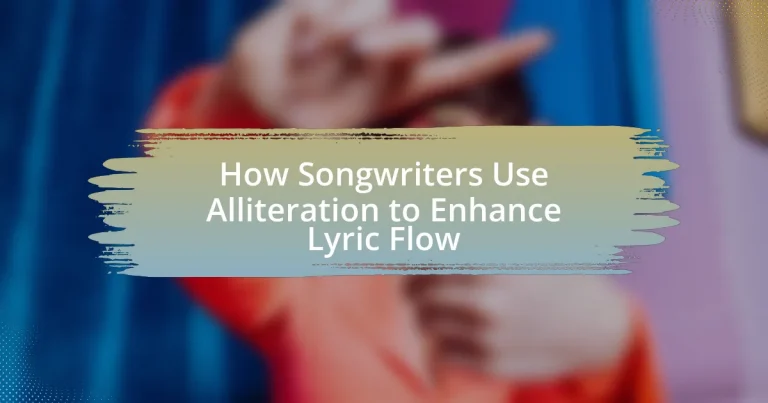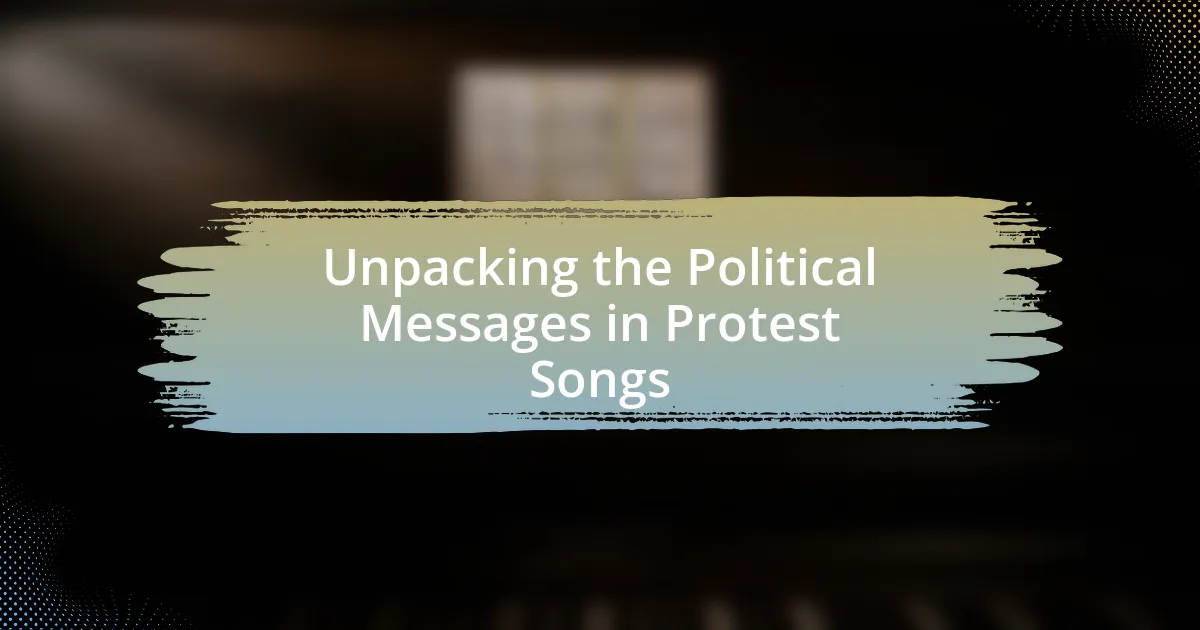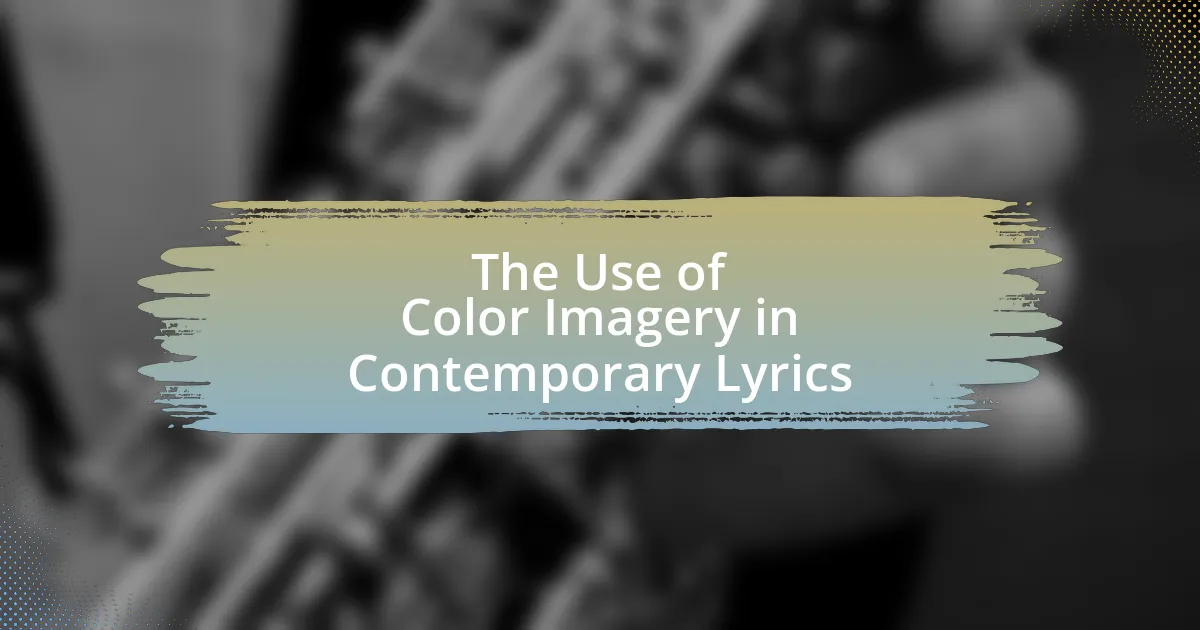Alliteration is a literary device that involves the repetition of initial consonant sounds in closely positioned words, and it plays a significant role in songwriting by enhancing lyric flow, creating rhythm, and making lyrics more memorable. This article explores how songwriters utilize alliteration to emphasize key themes and emotions, improve listener engagement, and contribute to the overall aesthetic of their music. It examines the effects of alliteration on the listener’s experience, provides examples from popular songs, and discusses techniques for effectively integrating alliteration into lyrics while maintaining lyrical depth and coherence. Additionally, it highlights best practices for songwriters to refine their use of alliteration for better lyric flow and memorability.
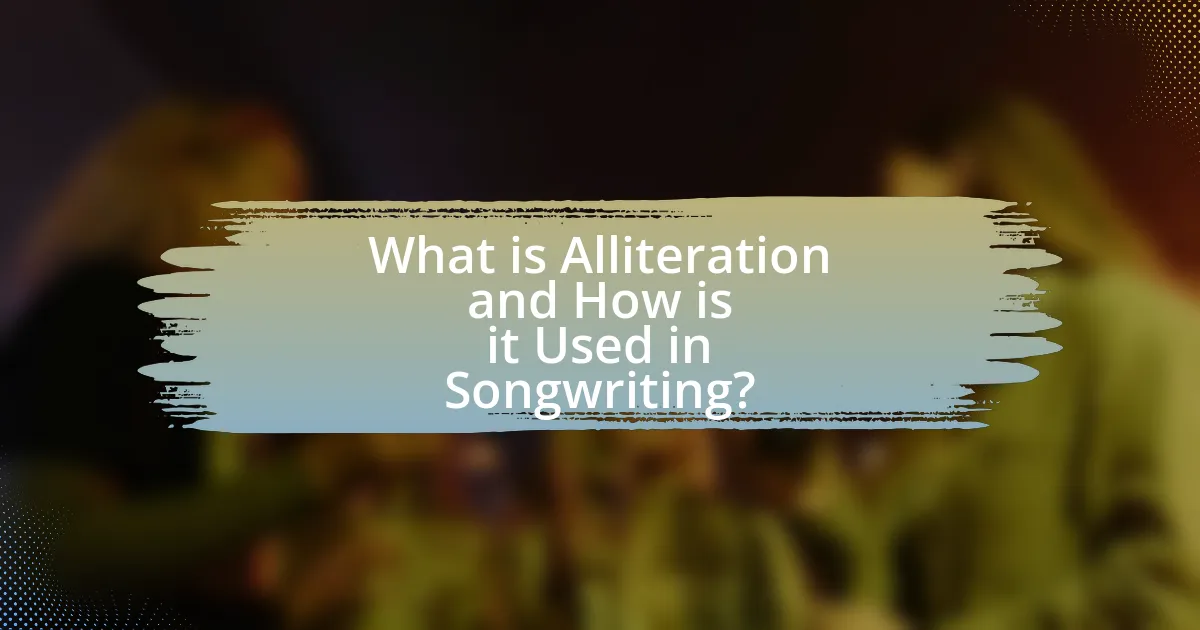
What is Alliteration and How is it Used in Songwriting?
Alliteration is a literary device characterized by the repetition of the same initial consonant sounds in closely positioned words. In songwriting, alliteration enhances lyric flow by creating rhythm, emphasizing particular phrases, and making lyrics more memorable. For example, in the song “Lucy in the Sky with Diamonds” by The Beatles, the repetition of the ‘s’ sound in “sky” and “stars” contributes to the song’s dreamy quality. This technique not only captures listeners’ attention but also reinforces the emotional tone of the lyrics, making them more impactful.
Why do songwriters choose to use alliteration in their lyrics?
Songwriters choose to use alliteration in their lyrics to create a rhythmic and memorable quality that enhances the overall flow of the song. Alliteration, the repetition of consonant sounds at the beginning of words, helps to establish a musicality that can make lyrics more engaging and easier to remember. For instance, many popular songs utilize alliteration to emphasize key themes or emotions, making the lyrics resonate more with listeners. This technique not only aids in memorability but also contributes to the aesthetic appeal of the song, as seen in works by artists like Eminem and Taylor Swift, who frequently employ alliteration to enhance their lyrical storytelling.
What effects does alliteration have on the listener’s experience?
Alliteration enhances the listener’s experience by creating a rhythmic and memorable quality in lyrics. This phonetic repetition captures attention and aids in retention, making the lyrics more engaging and easier to recall. Research indicates that alliteration can evoke emotional responses, as the sound patterns resonate with listeners, enhancing their connection to the music. For example, in popular songs, the use of alliteration often emphasizes key themes or emotions, reinforcing the overall message and making it more impactful.
How does alliteration contribute to the overall theme of a song?
Alliteration enhances the overall theme of a song by creating a rhythmic and memorable quality that reinforces the song’s message. This literary device draws attention to specific phrases, making them more impactful and easier for listeners to recall. For example, in songs like “Lucy in the Sky with Diamonds” by The Beatles, the repetition of initial consonant sounds emphasizes the whimsical and surreal themes, allowing the imagery to resonate more deeply with the audience. Such use of alliteration not only aids in lyric flow but also strengthens the emotional connection to the song’s central ideas.
What are some examples of alliteration in popular songs?
Examples of alliteration in popular songs include “Lucy in the Sky with Diamonds” by The Beatles, where the repetition of the ‘s’ sound enhances the dreamy imagery. Another example is “Big Pimpin'” by Jay-Z, which uses the ‘p’ sound to create a catchy rhythm. Additionally, “Shake It Off” by Taylor Swift features the ‘s’ sound, contributing to the song’s upbeat feel. These instances demonstrate how songwriters effectively use alliteration to enhance the lyrical flow and memorability of their music.
Which songwriters are known for their effective use of alliteration?
Songwriters known for their effective use of alliteration include Bob Dylan, Eminem, and Taylor Swift. Bob Dylan frequently employs alliteration in his lyrics, enhancing the poetic quality of his storytelling. Eminem is renowned for his intricate rhyme schemes and alliterative phrases, which contribute to his rapid-fire delivery and lyrical complexity. Taylor Swift utilizes alliteration to create memorable hooks and enhance the emotional resonance of her songs. These artists exemplify how alliteration can enhance lyric flow and engage listeners.
How do different genres utilize alliteration in their lyrics?
Different genres utilize alliteration in their lyrics to create rhythm, enhance memorability, and emphasize themes. For instance, hip-hop artists often employ alliteration to establish a strong beat and flow, as seen in the works of Eminem, who uses repeated consonant sounds to create intricate rhyme schemes. In pop music, artists like Taylor Swift use alliteration to make catchy hooks and memorable phrases, enhancing listener engagement. Rock bands, such as The Beatles, incorporate alliteration in their lyrics to evoke imagery and emotion, contributing to the overall storytelling. Each genre adapts alliteration to fit its unique style and audience, demonstrating its versatility as a lyrical device.
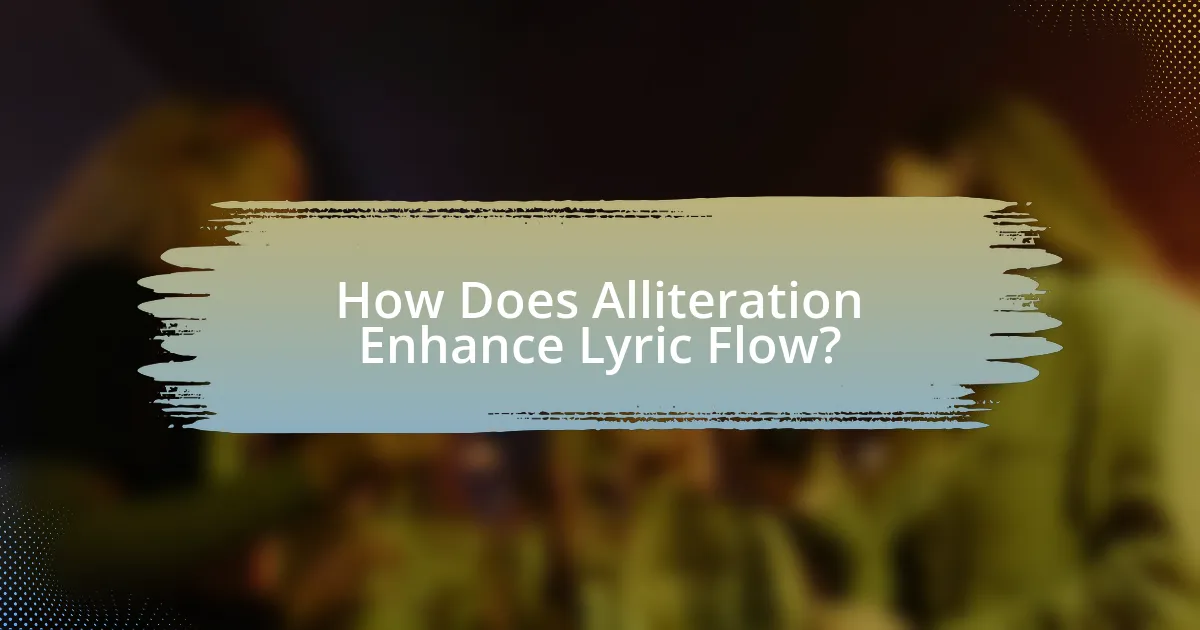
How Does Alliteration Enhance Lyric Flow?
Alliteration enhances lyric flow by creating a rhythmic and melodic quality that makes lyrics more memorable and engaging. This technique involves the repetition of initial consonant sounds in closely positioned words, which can establish a musicality that complements the song’s overall structure. For example, in the song “Lucy in the Sky with Diamonds” by The Beatles, the repeated ‘s’ sounds contribute to a dreamy, flowing quality that enhances the listener’s experience. Studies in linguistics indicate that alliteration can improve recall and emotional resonance, making lyrics more impactful and enjoyable for audiences.
What role does alliteration play in the rhythm of a song?
Alliteration enhances the rhythm of a song by creating a musical quality that complements the melody. This repetition of initial consonant sounds establishes a pattern that can make lyrics more memorable and engaging. For instance, in songs like “Lucy in the Sky with Diamonds” by The Beatles, the use of alliteration contributes to a flowing, lyrical structure that aligns with the song’s dreamy theme. This technique not only aids in the overall aesthetic of the song but also helps to emphasize key phrases, making them stand out to listeners.
How does alliteration affect the pacing of lyrics?
Alliteration affects the pacing of lyrics by creating a rhythmic flow that enhances the musicality of the words. This technique allows songwriters to manipulate the speed and emphasis of phrases, making certain lines feel quicker or more urgent while others may slow down for dramatic effect. For example, in the song “Lucy in the Sky with Diamonds” by The Beatles, the repetition of the ‘s’ sound contributes to a dreamy, flowing pace that complements the song’s surreal imagery. This deliberate use of sound patterns not only engages listeners but also reinforces the emotional tone of the lyrics, demonstrating how alliteration can effectively shape the overall pacing and impact of a song.
What techniques do songwriters use to integrate alliteration smoothly?
Songwriters use techniques such as phonetic matching, rhythmic placement, and thematic consistency to integrate alliteration smoothly. Phonetic matching involves selecting words that share similar sounds, enhancing the auditory appeal of the lyrics. Rhythmic placement ensures that alliterative phrases align with the song’s meter, creating a natural flow. Thematic consistency ties the alliterative words to the song’s subject matter, making the lyrics more cohesive and engaging. These methods are commonly employed in various musical genres, demonstrating their effectiveness in enhancing lyric flow.
How can alliteration create memorable hooks in songs?
Alliteration creates memorable hooks in songs by enhancing rhythm and making lyrics more engaging. This literary device involves the repetition of initial consonant sounds, which can create a musical quality that resonates with listeners. For example, in the song “Bad Blood” by Taylor Swift, the repeated ‘b’ sound not only emphasizes the theme but also makes the hook catchy and easy to remember. Research indicates that alliteration can improve recall and recognition, as it aids in the cognitive processing of lyrics, making them stick in the listener’s mind.
What are the characteristics of effective alliterative hooks?
Effective alliterative hooks are characterized by their rhythmic quality, memorability, and emotional resonance. These hooks utilize the repetition of initial consonant sounds to create a musicality that enhances the flow of lyrics, making them more engaging and easier to remember. For instance, the use of alliteration can evoke specific feelings or imagery, thereby deepening the listener’s connection to the song. Research indicates that songs with strong alliterative elements often achieve higher listener retention rates, demonstrating the effectiveness of this technique in songwriting.
How does alliteration help in making lyrics catchy and singable?
Alliteration enhances the catchiness and singability of lyrics by creating rhythmic patterns and memorable phrases. This literary device involves the repetition of initial consonant sounds, which can make lines more engaging and easier to remember. For example, songs like “Lucy in the Sky with Diamonds” by The Beatles utilize alliteration to create a melodic flow that sticks in the listener’s mind. Research indicates that alliterative phrases can improve recall and recognition, making them effective tools for songwriters aiming to craft memorable lyrics.

What Techniques Can Songwriters Use to Implement Alliteration?
Songwriters can implement alliteration by using techniques such as selecting words with the same initial consonant sounds, creating rhythmic patterns, and emphasizing key phrases. By carefully choosing words that start with the same letter, songwriters enhance the musicality and memorability of their lyrics. For example, in the song “Lucy in the Sky with Diamonds” by The Beatles, the repetition of the ‘s’ sound creates a flowing, dreamlike quality. This technique not only captures the listener’s attention but also reinforces the thematic elements of the song, demonstrating how alliteration can effectively enhance lyric flow.
How can songwriters brainstorm alliterative phrases?
Songwriters can brainstorm alliterative phrases by utilizing techniques such as word association, thesaurus exploration, and writing prompts. Word association involves generating a list of words that share the same initial consonant sound, which can spark creative connections. Thesaurus exploration allows songwriters to find synonyms that fit the desired sound pattern, expanding their vocabulary options. Writing prompts can also guide songwriters to think of specific themes or emotions, encouraging them to create phrases that resonate with their lyrical intent. These methods are effective because they stimulate creativity and help songwriters discover unique combinations that enhance the flow of their lyrics.
What exercises can help improve alliteration skills in songwriting?
Practicing tongue twisters is an effective exercise to improve alliteration skills in songwriting. These phrases often emphasize the repetition of initial consonant sounds, which helps songwriters develop a keen ear for sound patterns and rhythm. For example, phrases like “She sells seashells by the seashore” require quick articulation of similar sounds, enhancing fluency and creativity in lyric writing. Additionally, writing prompts that encourage the use of alliterative phrases can further strengthen this skill, as they challenge songwriters to think critically about word choice and sound. Engaging in these exercises consistently can lead to more fluid and engaging lyrics, ultimately enhancing the overall flow of a song.
How can songwriters avoid overusing alliteration?
Songwriters can avoid overusing alliteration by consciously varying their word choices and employing different literary devices. By incorporating synonyms, metaphors, or imagery, songwriters can maintain lyrical interest without relying heavily on alliteration. Research indicates that diverse vocabulary enhances listener engagement, as seen in studies analyzing popular song lyrics, which show that songs with varied linguistic structures tend to resonate more with audiences. This approach not only enriches the lyrical content but also prevents the monotony that can arise from excessive alliteration.
What are some common pitfalls when using alliteration in lyrics?
Common pitfalls when using alliteration in lyrics include overuse, which can lead to a lack of clarity and distract from the song’s message. When songwriters excessively employ alliteration, it may result in forced phrasing that feels unnatural or contrived, diminishing the emotional impact of the lyrics. Additionally, alliteration can create a monotonous sound if not varied appropriately, making the lyrics less engaging. Furthermore, if the alliterative phrases do not align with the song’s theme or mood, they can confuse listeners and detract from the overall coherence of the piece. These pitfalls highlight the importance of balance and intentionality in the use of alliteration to maintain lyrical effectiveness.
How can songwriters ensure alliteration enhances rather than detracts from their message?
Songwriters can ensure alliteration enhances their message by carefully selecting words that align with the song’s theme and emotional tone. This alignment allows alliteration to reinforce the intended meaning rather than distract from it. For instance, using alliteration with words that evoke strong imagery or emotions can create a memorable and impactful lyrical experience. Research indicates that effective use of alliteration can improve listener retention and engagement, as seen in popular songs where alliterative phrases contribute to the overall rhythm and flow, making the message more resonant.
What strategies can be employed to balance alliteration with lyrical depth?
To balance alliteration with lyrical depth, songwriters can employ strategies such as thematic consistency, varied syllable counts, and emotional resonance. Thematic consistency ensures that the alliterative phrases align with the overall message of the song, enhancing meaning rather than detracting from it. Varied syllable counts allow for a natural flow, preventing the alliteration from becoming overly repetitive or forced, which can dilute lyrical depth. Emotional resonance is crucial; using alliteration to evoke strong feelings can deepen the listener’s connection to the lyrics, making the alliteration feel purposeful and impactful. These strategies collectively maintain the integrity of the lyrics while enhancing their musicality.
What are best practices for using alliteration in songwriting?
Best practices for using alliteration in songwriting include selecting consonant sounds that create a pleasing auditory effect, ensuring that the alliteration enhances the lyrical meaning rather than detracting from it, and varying the placement of alliterative phrases to maintain listener interest. For instance, using alliteration at the beginning of lines can create a strong rhythmic impact, while incorporating it within lines can add depth to the imagery. Research indicates that alliteration can improve memorability and engagement in lyrics, as seen in popular songs where artists like Eminem and Taylor Swift effectively use this technique to create catchy hooks and memorable verses.
How can songwriters effectively combine alliteration with other literary devices?
Songwriters can effectively combine alliteration with other literary devices by strategically using rhyme, imagery, and metaphor to enhance the lyrical flow and emotional impact of their songs. For instance, incorporating alliteration alongside vivid imagery can create a more immersive experience for listeners, as seen in the works of artists like Bob Dylan, who often pairs alliterative phrases with strong visual elements. This technique not only emphasizes the sound of the words but also reinforces the thematic content, making the lyrics more memorable and engaging. Additionally, using alliteration in conjunction with metaphor can deepen the meaning of the lyrics, allowing songwriters to convey complex emotions succinctly, as demonstrated in the songwriting of Leonard Cohen, where alliterative lines often serve to amplify the metaphorical weight of his messages.
What tips can help songwriters refine their use of alliteration for better lyric flow?
To refine their use of alliteration for better lyric flow, songwriters should focus on selecting consonant sounds that complement the song’s mood and theme. This involves experimenting with different sounds to find those that create a pleasing auditory effect, enhancing the overall rhythm and melody of the lyrics. Additionally, songwriters can practice varying the placement of alliterative phrases within lines to maintain listener interest and avoid predictability. For instance, using alliteration at the beginning, middle, or end of lines can create dynamic shifts in flow. Furthermore, analyzing successful songs that effectively use alliteration can provide insights into techniques that resonate with audiences, reinforcing the importance of context and emotional impact in lyric writing.
